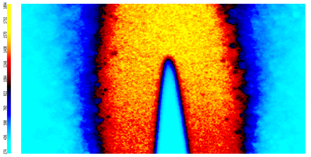Rayleigh Thermometry
The analysis and optimization of combustion processes requires accurate measurement of several parameters including global temperature distribution. By using laser Rayleigh scattering, two-dimensional temperature maps can be derived from the resulting images from clean combustion and hot gas flows.
Rayleigh Thermometry data is obtained in a plane by illuminating the process under investigation with a thin laser light sheet. The elastically scattered light from the gas molecules is then recorded by an intensified CCD camera placed perpendicular to the light sheet. Since the intensity of the scattered light is directly related to the gas density, we can now use the grey level data from the images to determine the temperature.

Temperature profile of flame
LPG Gas Temperature Measurement
The software allows the user to edit and export groups of raw images, temperature and re-sampled maps into standard file formats. This simplifies the ability import the results to other custom analysis methods or to compare the data with numerical CFD results. Export facilities are designed to allow high flexibility with the format of the data (grid, metric or pixel coordinates system, number of precision digits for the scalar) in order to provide the user with data files that can be further processed without additional time-consuming modifications